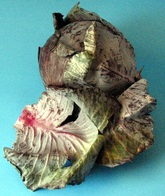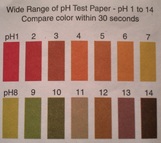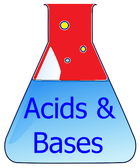
This is a follow-up post to the previous entry on acids and bases. The demonstration video illustrates the pH response of anthocyanin, the dye extracted from red cabbage leaves. Anthocyanin, sometimes referred to as "anthocyan" can be extracted from many vegetables, fruits, and flowers using any one of several methods.
Despite the fact that this experiment has been around for several years, it still has the potential to have value in the study of natural acid and base indicators. The chemistry of natural indicators, particularly anthocyanin, is very complex and still contains mysteries about its structure and role in nature. I had originally intended to include the Indian spice turmeric in this post, also as an indicator of pH, but while working with it I found that it has the possibility of being used as an imaging material. So, I will continue working on that area and post as soon as I have concluded the research. After the video, the writeup will provide a step-by-step procedure to red cabbage leaf extraction, and useful links to fill out the discussion. Enjoy!

Materials for the experiment:
Red cabbage, available all year around in most markets.
Distilled water.
Blender (stirring can be used instead but will take longer).
Hydrochloric acid (available at hardware stores as muriatic acid, 28% HCl).
Sodium Hydroxide (available at hardware stores as lye, or drain cleaner NaOH 100%.
Coffee filters or filter paper to separate the cabbage mush from the liquid.
Acetone (optional for additional experiments). Hardware store.
Ethyl Alcohol 70% (optional, rubbing alcohol from the drugstore for additional experiments).
Procedure:
First, prepare the cabbage extract by either tearing or cutting three or four cabbage leaves into small pieces and place into the blender. Add a small amount of hot distilled water and blend until the color is as dark as possible. This takes less than 2 minutes. Filter twice to allow collection of the cabbage mush and the clean extract of anthocyanin. Discard the mush and set the extract aside and prepare the acid and base.
CAUTION! The next step is to prepare the HCl and NaOH solutions. Muriatic acid tends to fume and is a strong acid. Lye is a strong base and can cause burns. Wear gloves, protective eye wear, and prepare with adequate ventilation.
0.1 Molar solution sodium hydroxide. Dissolve 4.0 grams of NaOH (lye) in enough distilled water to make 1 liter. This has a pH of 13.
0.1 Molar hydrochloric acid solution. Add 17 ml of muriatic acid (28% HCl) to make 1 liter of solution. This has a pH of 1.
Then follow this serial dilution procedure:
1. Label 13 test tubes or other containers from 1 to 13.
2. Place 9.0 ml of distilled or deionized water in all test tubes except #1 and #13.
3. Prepare solutions in the acid range in the following manner:
a. Place 10.0 ml of 0.1 M HCl in test tube #1. (pH = 1)
b. Transfer 1.0 ml of 0.1 M acid from test tube #1 to test tube #2 and mix thoroughly. (pH = 2)
c. Transfer 1.0 ml of acid solution from test tube $2 to test tube #3 and mix thoroughly. (pH = 3)
d. Continue making the serial dilutions by transferring 1.0 ml of the most recently diluted acid solution to the next test tube until six acid solutions of pH 1 to 6 have been prepared. Be sure to mix each thoroughly before the transfer.
4. Add 10.0 ml distilled or deionized water to test tube #7. (pH = 7)
5. Prepare solutions of base in the following way:
a. Place 10.0 ml of 0.1 M NaOH in test tube #13. (pH = 13)
b. Transfer 1.0 ml of 0.1 M NaOH from test tube #13 to test tube #12 and mix thoroughly. (pH = 12)
c. Continue making serial dilutions of the base going from pH 12 down to pH 8 by transferring 1.0 ml of the most recently diluted basic solution to the next test tube and mixing thoroughly each time. Then, add enough of the anthocyanin extract to see the color change as in the video. To extract with acetone or ethyl alcohol, simply place a small amount of cabbage leaves in a glass container and add the solvent to just cover the leaves. Allow 24 hours with occasional stirring to get the extraction. Filter and proceed with any other experiments.
Here are some links to check out:
Chemistry of anthocyanin in detail with experiments here.
Wikipedia entry for anthocyanin. Check out the test tube photo with the blue sample. I am not sure how that happens. This entry also includes a list of some of the other sources of anthocyanin here.
American Science and Surplus source of pH paper. Look under lab supplies for pH paper but, there are other suppliers as well here.
Recipe for the Yamada universal indicator here.
I think that this is an interesting area of investigation and as always, I welcome comments. Color me gone...

 RSS Feed
RSS Feed
